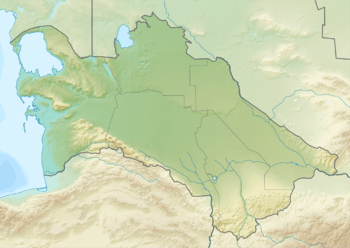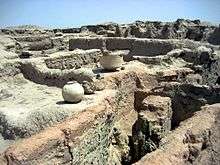Gonur Depe
Gonur Depe (Turkmen: Goňur depe) is an archaeological site located about 60 km north of Mary (ancient Merv), Turkmenistan consisting of a large early Bronze Age settlement. It is the "capital" or major settlement of the Bactria–Margiana Archaeological Complex (BMAC) dated from 2400-1600 BCE.[1]
Goňur depe (in Turkmen) | |
 Location in Turkmenistan | |
| History | |
|---|---|
| Periods | Bronze Age |
| Cultures | BMAC |
Archaeology
The site was discovered in the 1950s by Greek-Russian archaeologist Viktor Sarianidi, and excavated in the 1970s. Sarianidi uncovered a palace, a fortified mud-brick enclosure, and temples with fire altars which he associated with the Zoroastrian religion.[2]
Gonur Depe has a total area of about 55 hectares. The northern part of the complex had a central citadel-like structure about 100 by 180 m (330 by 590 ft) in size. A southern complex is about 1.5 hectares in size.
Gonur is among the largest ruins in the Murghab river delta region; over 150 ancient settlements have been found here.
Soma drink
He also found what appears to be the boiler for the ritual drink soma, which is mentioned in the Rigveda and also in the Avesta as haoma. Sarianidi says he also found dishes with traces of cannabis, poppy and ephedra. According to Sarianidi, this discovery strengthens the theory that these were the ingredients of soma.[3]
The excavations of the settlement of Ulug Tepe, near Dushak in south Turkmenistan, found similar implements for making soma drink, described as a "pressure set". The finds were made in the Late Bronze layers.
The implements,
- "... consisted of a huge stone mortar and a pestle, a pressing stone with a half-spheric projection in its centre and next to it a similar one with a half-spheric deepening."[3]
South Turkmenistan also belonged to the area of Bactria-Margiana Archaeological Complex.
Historical context
Scholars believe that the ancient Oxus river culture (Bactria-Margiana) may have its origin at sites like Anau, on the northern slopes of the Kopet-Dag mountains. Anau dates back to 6500 B.C. Later settlements like Gonur may have been founded by people who moved there from the Kopet-Dag area because of changing climate.[4]

There were increasing incursions of nomadic encampments of the Andronovo culture at the site during the period 1800-1500 BCE. According to Lamberg-Karlovsky, presence of Andronovo pottery at Gonur, the characteristic ceramics of the Eurasian steppes where the modern horse was domesticated, certainly implies that the horse was known to the BMAC. However, Sarianidi disregards the steppe connection for the presence of the horse in BMAC.[5]
Mallory (1997) points out that the BMAC fortified settlements such as Gonur and Togolok resemble the qila, the type of fort known in this region in the historical period. They may be circular or rectangular and have up to three encircling walls. Within the forts are residential quarters, workshops and temples.[6]
The site was most likely abandoned after the course of the Murghab River shifted to the west.
See also
References
- Frenez, Dennys, (2018). "Manufacturing and trade of Asian elephant ivory in Bronze Age Middle Asia: Evidence from Gonur Depe (Margiana, Turkmenistan)"in Archaeological Research in Asia 15, p. 15.
- "predating Zoroaster [1000 BC?] by at least fifteen hundred years but linked with what would become the rituals of his faith". S. Frederick Starr, Lost Enlightenment. Princeton University Press, 2013, p. 73
- Sarianidi, Victor, (2003). Margiana and Soma-Haoma. Electronic Journal of Vedic Studies (EJVS), Vol. 9 (2003) Issue 1c (May 5); archived 10 May 2020
- Andrew Lawler, Central Asia's Lost Civilization -- The unveiling of a 4,000-year-old civilization calls into question conventional ideas about ancient culture, trade, and religion. November 29, 2006 discovermagazine.com
- Lamberg-Karlovsky, Clifford Charles. "The Oxus Civilization / La Civilización del Oxus". CuPAUAM. 39: 21–63.
- "BMAC" in: Mallory, J. P.; Adams, D. Q., Encyclopedia of Indo-European Culture (1997), p. 72.
External links
- Eduljee, K. E. "Gonur Mouru Region". Retrieved 23 April 2013.
- Michael Wood (January 2009). The Story of India: Beginnings (DVD). PBS Home Video/British Broadcasting Corporation. Event occurs at 0:37. OCLC 368005891.
- Black Sands documentary Anastasis Agathos (June 2010). Black Sands (52min, documentary trailer). Urgh Productions.